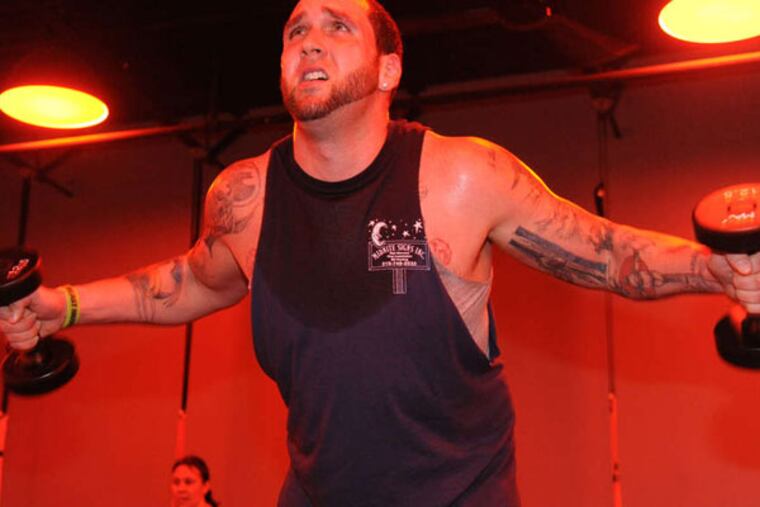Well Being: Orangetheory Fitness aims to maximize cardio workout
When Orangetheory Fitness was pitched to me last fall, I was intrigued. I thought it might be a workout program based on my favorite fruit, a citrus-powered way to a better body.

When Orangetheory Fitness was pitched to me last fall, I was intrigued. I thought it might be a workout program based on my favorite fruit, a citrus-powered way to a better body.
Turns out Orangetheory Fitness, which began in Florida, is a new type of high-energy, high-intensity circuit training that aims to burn a large number of calories during and after the session.
Orange refers not to the fruit but to an exertion zone equivalent to 85 percent of your maximum heart rate. The theory goes that if you can stay in that fat-burning orange zone for 12 to 20 minutes during the hour-long workout, it will "jump-start your metabolism," and you'll benefit from a post-exercise afterburn that can last up to 36 hours and consume an average of 300 additional calories.
So says Adrienne Gerhart, manager and part-owner of the new Orangetheory Fitness studio that opened in the Willow Grove Shopping Center in December. It is the first in Pennsylvania, she says.
Post-exercise afterburn refers to the body's recovery from oxygen debt after intense exertion. A more technical term is EPOC, or excess post-exercise oxygen consumption. There is some debate about how long the afterburn lasts and how many calories are consumed before it tails off.
Gerhart, 30, who grew up in Lancaster County and is a former Division 1 field hockey player, says the typical participant burns 500 to 900 calories during the hour-long workout. That's believable to me because the other night, I gave it a try.
The gleaming studio, bathed in orange light, features many gadgets, from state-of-the art treadmills to rowing machines that derive their resistance from water.
I was fitted with a heart-rate monitor, like all participants. The monitor transmits data to a large screen so you can chart your performance and compare it to everyone else's.
Workouts are based on science and psychology, Gerhart says. The science involves the heart-rate monitor and the ideal zone for burning calories and fat. The psychology involves exercising in a group, which stimulates competition and motivation. The groups are kept small - no more than two dozen to a class - enhancing intimacy and personal contact.
"We support and encourage everyone that comes in the door," Gerhart says. "We know your name and fitness goals and talk to you about them and hold you accountable. It's like a family, a team. You don't get that at a big-box gym."
My class was led by head trainer Jenn Stocklos, 32, who is shapely and firm, with body fat, no doubt, in single digits. She knows when to push and when to back off. She figuratively lashes those who are dogging it, and attends to the limits of tyros and those beset by injury.
"Everybody can do this, from a power walker to a 90-year-old grandmother," Stocklos declared.
In my case, she quickly noticed my arthritic right foot and wobbly knees. She modified the lunge portion of the workout to make it easier for me to keep my balance.
For the first half of the session, half the class, including me, was assigned to the treadmills. Stocklos let us warm up at an easy pace. Then she told us to set the pace at a taxing but manageable run. After a few minutes, she told us to set the pace two levels higher so we were virtually sprinting for 30 seconds. We repeated this sequence several times, and afterward were thoroughly winded and drenched.
The procedure was the same on the rowing machines, except after rowing 200 meters, we dismounted and began doing jumping jacks, sometimes lifting a weight plate over our heads, other times thrusting it out straight in front of us. Then, back to the rowing machines for another 200 meters, at rates again that pushed our cardiovascular systems into the orange zone and beyond.
With dumbbells, we did crunches and flies and lunges, as well as ungainly push-ups on BOSU balls. Stocklos, ever upbeat and encouraging, saluted individual achievement, corrected and adjusted form. She made sure we all exerted ourselves for the full 60 minutes.
"Jenn doesn't let me slow down," said Alicia McGovern, 26, of Abington, who goes every day and so has more toned thighs and a flatter abdomen. "I need the motivation to keep going, and the monitors really help. I see where I am and how much improvement I need to make. And when I leave, I always feel better and more energized."
It left me exhausted but exhilarated. My personal training report showed I burned 646 calories and managed to stay in the orange zone for 18 minutes, or 32 percent of the session. I trust the caloric afterburn vaporized any delinquent fat cells.
"Well Being" appears every other week, alternating with Sandy Bauers' "GreenSpace" column. Contact Art Carey at art.carey@gmail.com. Read his recent columns at www.philly.com/wellbeing.